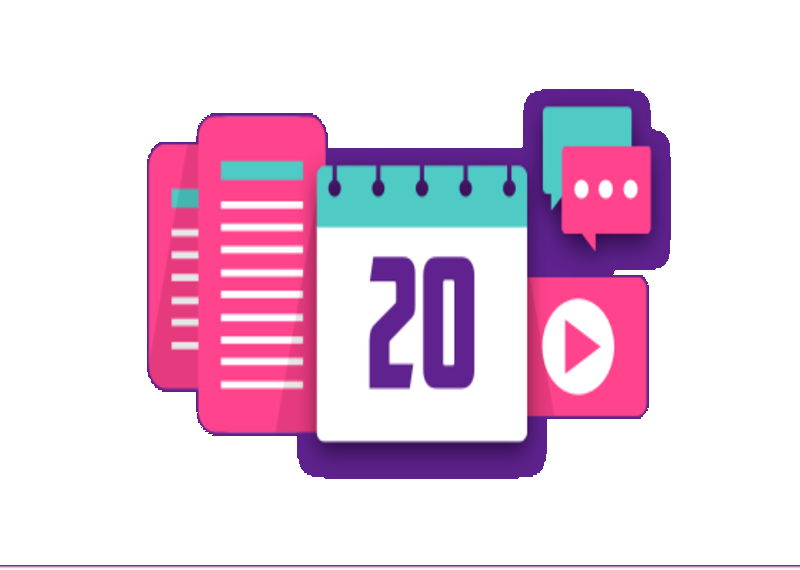What do you need for a content calendar?

Businesses tend to be motivated to create and share more content, but the scarcity of time and human resources often gets in the way. A content calendar is a simple way to overcome this problem and make the best use of your company's scarce resources. It's an effective tool for coordinating content creation and helps you divide your team's upcoming workload into clear, manageable units.
By integrating this tool into your planning process, you can spend less time wondering what to write and more time focusing on the creation itself. We've put together 10 tips to help you get started on creating your own content calendar:
1. Identify your goals
When planning your future content, start by asking yourself: what is your main goal with it? The answer to this question should determine the right channel and format. Does the content aim to generate new leads, drive readers to your website, increase visibility or perhaps increase your Facebook followers?
The goals you set will have a significant impact on who you publish content to, where and how often. That's why it's important that your team is clear about your goals before and during the planning process.
So setting goals should be the first step in implementing a content calendar. If you publish content without a clear goal, it will not benefit your business - it will just waste resources. Everyone working on each project or item in the calendar should have a clear idea of what the expected outcomes are.
2. Create a template for the calendar
There are many tools on the web that offer calendar functionality - feel free to choose the template that best suits you. However, as implementing new software can be time-consuming, a content calendar can be as simple as a simple spreadsheet.
The calendar should have a sharing option if you plan to share content with the whole organisation. For example, you can create a calendar template using the free Google Sheets tool, which allows anyone involved in content creation to edit the page on their own computer to add comments and ideas.
You can build your content calendar according to your team's specific needs, but at a minimum it should include the following information:
- The channel on which the content will be published
- The topic
- Type of content
- Date and time of publication
- The person responsible
- Follow-up: has the content been published according to schedule?
3. Select the channels
Find out which channels your current and potential customers use. This will help you determine what content you should focus on creating. Should you publish articles on your blog? Photos on Instagram and Twitter? Videos on YouTube? A survey on Facebook?
It can be beneficial to publish content on different platforms and in different formats, as this broadens your audience. However, make sure you have enough resources to focus on the platforms you choose to publish on. Prioritise your key channels and focus on creating quality content rather than posting aimlessly on every platform imaginable.
Posts on social media are generally the easiest and least time-consuming type of content. However, make sure your content calendar is not just a social media calendar, but also includes other, deeper content.
Press releases, expert articles, and guest blogs should also be included in your annual communications and marketing plan, as they are likely to provide more information and greater value to your potential customers.
In addition, social media can be used as an effective tool for cross-promotion and sharing deeper content. Posting an infographic from a blog post on Instagram or sharing an article on LinkedIn or Twitter will generate more traffic and bring customers to your website.
4. Start with the calendar year
Use the calendar year as a basis when you start planning your content. Identify any important events that you want to build content around - holidays, fairs, seminars and training courses. This simple step will help you determine what seasonal content you'll need in the future and help you estimate your upcoming workload, allowing your team to prepare in advance.
5. Add your own content
Once you've written down all the important dates, start filling in the blanks with relevant content ideas. This content could include:
- Thematic entries - Attending a trade fair or seminar? Something related to your operation is the current topic? Follow the general conversation in your field and quickly grasp current topics.
- Series posts - Do you specialise in a service that you want to tell your customers more about? Series posts are a great way to educate and highlight your expertise.
- Expert articles and guest blogs on your services and current topics in your field.
- Press releases about a new product launch, research findings, or your company going international, to name a few.
- Seasonal or festive greetings
- Videos or pictures of events, campaigns, products and projects
- Stakeholder stories and interviews in video or case study form
- Interesting and funny details about the organisation - Who visits the office and what happens during coffee breaks?
Make sure you have enough relevant ideas to fill your calendar. Keep the content varied to keep it interesting.
6. Keep evergreen content handy
Content that is not tied to a specific date or time will always remain useful to both your customers and your company. Because contemporary topics remain relevant and are constantly searched for online, this type of content is likely to continue to receive clicks and visits even after the initial hype following publication.
You can also easily re-engage your audience with older, timeless articles and blog posts by placing links to your more recent content on similar topics.
Timeless content can also save you when you have delays in your schedule. Because you can create and publish content at any time, it's good to have ready-made content stored somewhere that you can use when your team might need to prioritise other tasks. Have a place in your calendar for timeless, ready-to-use content ideas.
7. Use previous content
You don't always have to create content from scratch. Most companies have useful content that hasn't been used yet, such as data from CRM systems and customer survey results.
Old blog posts can also be recycled and updated through different channels, for example, turned into short videos. Your potential customers may be looking for information on different platforms, so it can be a good idea to present similar ideas in different formats. This way you can make the most of all the valuable content you create by reaching different audiences.
It's also important that the content on your site is up to date, as many potential customers will browse through your older blog posts or articles. By reviewing and updating them periodically to ensure the accuracy of your content, you can appear professional and trustworthy.
Highlight updated articles so that your readers know that your content is up to date and that you intend to keep making it more valuable to them.
8. Decide on the frequency of publication and set time limits
Think about how often you can realistically publish new content. As content creation is time-consuming, it is important to choose a publishing frequency that suits you. Understanding your own limits is key to the effectiveness of your calendar. If it is too full, your content will suffer. However, you should have enough content to generate traffic to your site and provide value to your customers on a regular basis.
A content calendar will help you identify the busiest periods for your business. Planning ahead will help both individuals and your entire team prepare for your company's busiest months by ensuring that projects are started and completed well in advance of the publication date. In other words, planning should always be time-bound to ensure deadlines are met.
However, the content calendar should not be set in stone - a degree of flexibility should be considered and allowed for in the schedule. There may be occasions when your company needs to be able to react quickly to external events or news affecting your area. Therefore, it may sometimes be a good idea to postpone originally planned and less urgent content and react to breaking news instead.
9. Updating and reviewing the plan
There is no definitive answer as to how far in advance content should be planned. Planning ahead depends on a number of factors, such as how volatile your industry is and possibly some factors specific to your company.
However, you should bear in mind that the more advance you plan your content, the better it is to keep the flow of content smooth. A simple guideline is to plan your main content for the whole year, and then plan more detailed weekly and daily content for the following month.
Allow individuals to share their thoughts and update their plans as needed. A good idea might be to review the content calendar regularly with the whole team. This will help you to stay on track and adapt to any changes.
10. Monitor how your content is received
One of the great things about digital marketing is that almost everything can be measured. However, once a company spends a significant amount of time creating and sharing quality content, measuring the actual impact of the content often takes a back seat.
It's worth taking some time to look at your own operations and data, and factor them into future plans. Which posts on social media have generated the most conversation? Which blog posts were shared? How much media visibility did your press releases receive?
If you already know what content your readers are interested in, you can evolve in the future and create more interesting and engaging content.
